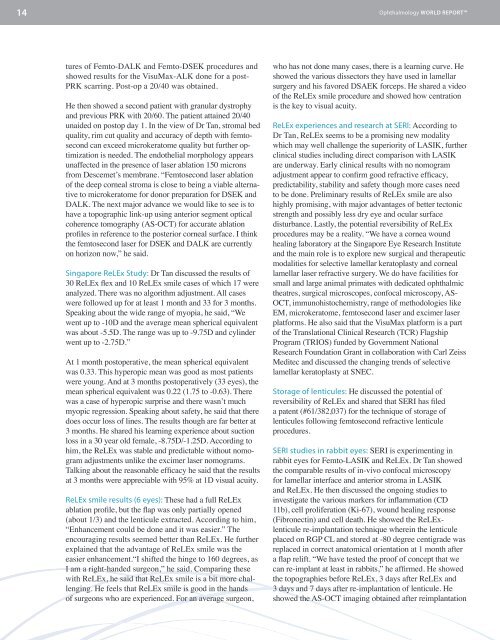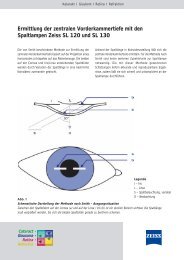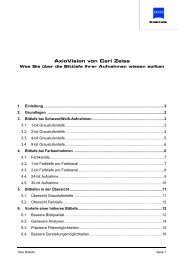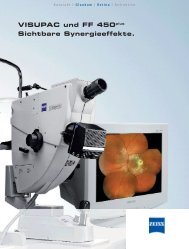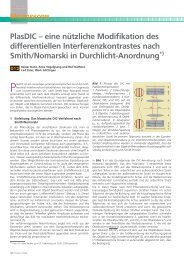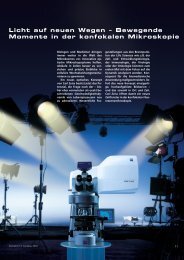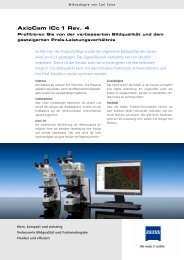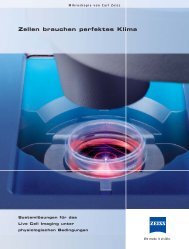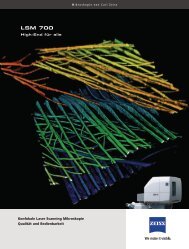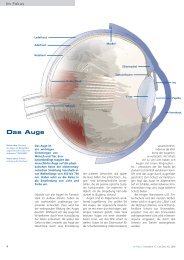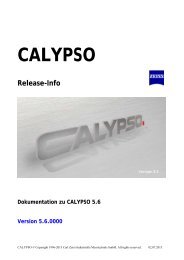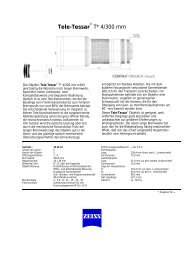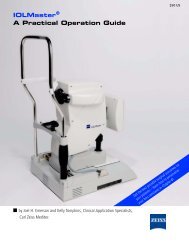FEMTO-LASIK and BEYOND - Carl Zeiss, Inc.
FEMTO-LASIK and BEYOND - Carl Zeiss, Inc.
FEMTO-LASIK and BEYOND - Carl Zeiss, Inc.
You also want an ePaper? Increase the reach of your titles
YUMPU automatically turns print PDFs into web optimized ePapers that Google loves.
14<br />
Ophthalmology WORLD REPORT<br />
tures of Femto-DALK <strong>and</strong> Femto-DSEK procedures <strong>and</strong><br />
showed results for the VisuMax-ALK done for a post-<br />
PRK scarring. Post-op a 20/40 was obtained.<br />
He then showed a second patient with granular dystrophy<br />
<strong>and</strong> previous PRK with 20/60. The patient attained 20/40<br />
unaided on postop day 1. In the view of Dr Tan, stromal bed<br />
quality, rim cut quality <strong>and</strong> accuracy of depth with femtosecond<br />
can exceed microkeratome quality but further optimization<br />
is needed. The endothelial morphology appears<br />
unaffected in the presence of laser ablation 150 microns<br />
from Descemet’s membrane. “Femtosecond laser ablation<br />
of the deep corneal stroma is close to being a viable alternative<br />
to microkeratome for donor preparation for DSEK <strong>and</strong><br />
DALK. The next major advance we would like to see is to<br />
have a topographic link-up using anterior segment optical<br />
coherence tomography (AS-OCT) for accurate ablation<br />
profiles in reference to the posterior corneal surface. I think<br />
the femtosecond laser for DSEK <strong>and</strong> DALK are currently<br />
on horizon now,” he said.<br />
Singapore ReLEx Study: Dr Tan discussed the results of<br />
30 ReLEx flex <strong>and</strong> 10 ReLEx smile cases of which 17 were<br />
analyzed. There was no algorithm adjustment. All cases<br />
were followed up for at least 1 month <strong>and</strong> 33 for 3 months.<br />
Speaking about the wide range of myopia, he said, “We<br />
went up to -10D <strong>and</strong> the average mean spherical equivalent<br />
was about -5.5D. The range was up to -9.75D <strong>and</strong> cylinder<br />
went up to -2.75D.”<br />
At 1 month postoperative, the mean spherical equivalent<br />
was 0.33. This hyperopic mean was good as most patients<br />
were young. And at 3 months postoperatively (33 eyes), the<br />
mean spherical equivalent was 0.22 (1.75 to -0.63). There<br />
was a case of hyperopic surprise <strong>and</strong> there wasn’t much<br />
myopic regression. Speaking about safety, he said that there<br />
does occur loss of lines. The results though are far better at<br />
3 months. He shared his learning experience about suction<br />
loss in a 30 year old female, -8.75D/-1.25D. According to<br />
him, the ReLEx was stable <strong>and</strong> predictable without nomogram<br />
adjustments unlike the excimer laser nomograms.<br />
Talking about the reasonable efficacy he said that the results<br />
at 3 months were appreciable with 95% at 1D visual acuity.<br />
ReLEx smile results (6 eyes): These had a full ReLEx<br />
ablation profile, but the flap was only partially opened<br />
(about 1/3) <strong>and</strong> the lenticule extracted. According to him,<br />
“Enhancement could be done <strong>and</strong> it was easier.” The<br />
encouraging results seemed better than ReLEx. He further<br />
explained that the advantage of ReLEx smile was the<br />
easier enhancement.“I shifted the hinge to 160 degrees, as<br />
I am a right-h<strong>and</strong>ed surgeon,” he said. Comparing these<br />
with ReLEx, he said that ReLEx smile is a bit more challenging.<br />
He feels that ReLEx smile is good in the h<strong>and</strong>s<br />
of surgeons who are experienced. For an average surgeon,<br />
who has not done many cases, there is a learning curve. He<br />
showed the various dissectors they have used in lamellar<br />
surgery <strong>and</strong> his favored DSAEK forceps. He shared a video<br />
of the ReLEx smile procedure <strong>and</strong> showed how centration<br />
is the key to visual acuity.<br />
ReLEx experiences <strong>and</strong> research at SERI: According to<br />
Dr Tan, ReLEx seems to be a promising new modality<br />
which may well challenge the superiority of <strong>LASIK</strong>, further<br />
clinical studies including direct comparison with <strong>LASIK</strong><br />
are underway. Early clinical results with no nomogram<br />
adjustment appear to confirm good refractive efficacy,<br />
predictability, stability <strong>and</strong> safety though more cases need<br />
to be done. Preliminary results of ReLEx smile are also<br />
highly promising, with major advantages of better tectonic<br />
strength <strong>and</strong> possibly less dry eye <strong>and</strong> ocular surface<br />
disturbance. Lastly, the potential reversibility of ReLEx<br />
procedures may be a reality. “We have a cornea wound<br />
healing laboratory at the Singapore Eye Research Institute<br />
<strong>and</strong> the main role is to explore new surgical <strong>and</strong> therapeutic<br />
modalities for selective lamellar keratoplasty <strong>and</strong> corneal<br />
lamellar laser refractive surgery. We do have facilities for<br />
small <strong>and</strong> large animal primates with dedicated ophthalmic<br />
theatres, surgical microscopes, confocal microscopy, AS-<br />
OCT, immunohistochemistry, range of methodologies like<br />
EM, microkeratome, femtosecond laser <strong>and</strong> excimer laser<br />
platforms. He also said that the VisuMax platform is a part<br />
of the Translational Clinical Research (TCR) Flagship<br />
Program (TRIOS) funded by Government National<br />
Research Foundation Grant in collaboration with <strong>Carl</strong> <strong>Zeiss</strong><br />
Meditec <strong>and</strong> discussed the changing trends of selective<br />
lamellar keratoplasty at SNEC.<br />
Storage of lenticules: He discussed the potential of<br />
reversibility of ReLEx <strong>and</strong> shared that SERI has filed<br />
a patent (#61/382,037) for the technique of storage of<br />
lenticules following femtosecond refractive lenticule<br />
procedures.<br />
SERI studies in rabbit eyes: SERI is experimenting in<br />
rabbit eyes for Femto-<strong>LASIK</strong> <strong>and</strong> ReLEx. Dr Tan showed<br />
the comparable results of in-vivo confocal microscopy<br />
for lamellar interface <strong>and</strong> anterior stroma in <strong>LASIK</strong><br />
<strong>and</strong> ReLEx. He then discussed the ongoing studies to<br />
investigate the various markers for inflammation (CD<br />
11b), cell proliferation (Ki-67), wound healing response<br />
(Fibronectin) <strong>and</strong> cell death. He showed the ReLExlenticule<br />
re-implantation technique wherein the lenticule<br />
placed on RGP CL <strong>and</strong> stored at -80 degree centigrade was<br />
replaced in correct anatomical orientation at 1 month after<br />
a flap relift. “We have tested the proof of concept that we<br />
can re-implant at least in rabbits,” he affirmed. He showed<br />
the topographies before ReLEx, 3 days after ReLEx <strong>and</strong><br />
3 days <strong>and</strong> 7 days after re-implantation of lenticule. He<br />
showed the AS-OCT imaging obtained after reimplantation


